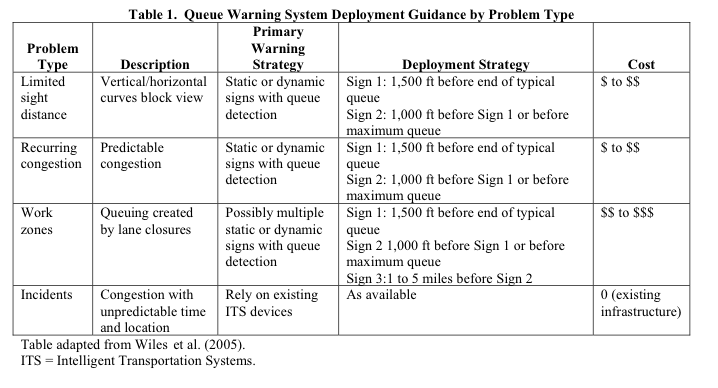VIRGINIA CENTER FOR TRANSPORTATION INNOVATION AND RESEARCH
Introduction
A number of European countries have implemented programs that use technology to manage congestion dynamically. These programs are collectively termed Active Traffic Management (ATM). European ATM programs have produced significant improvements in traffic flow and safety at a lower cost than traditional capacity expansion projects. A recent European scan by the Federal Highway Administration (FHWA) and the American Association of State Highway and Transportation Officials (AASHTO) identified a number of promising ATM techniques that could potentially be transferred to roads in the United States (Mirshahi et al., 2007). The FHWA/AASHTO scan examined ATM systems in Greece, Denmark, the Netherlands, Germany, and the United Kingdom. The scan found significant, broad benefits of using ATM, including the following:
- increases in throughput of 3% to 7% during congested periods
- decreases in primary incidents of 3% to 30% and decreases in secondary incidents of 40% to 50%
- increased trip reliability
- improved ability to delay the onset of breakdown conditions (Mirshahi et al., 2007).
Although the FHWA/AASHTO scan results represent only one data point in the assessment of ATM, they provide positive indications regarding the potential impacts of ATM on congestion and safety. The scan found several categories of ATM techniques that showed particular promise, specifically:
- speed harmonization using variable speed limit (VSL) systems
- dynamic use of the shoulder
- junction control and dynamic lane control
- queue warning systems (QWSs)
- dynamic ramp metering.
Although Europe has had experience with ATM techniques, applications in the United States are more limited. The Washington State Department of Transportation (DOT) (WSDOT) recently implemented VSL systems and lane control signs on S.R. 520, I-5, and I-90 (Jacobson, 2012). The Virginia Department of Transportation (VDOT) has begun exploring the use of ATM methods. Virginia deployed a VSL system on the Capital Beltway at the Woodrow Wilson Bridge in an attempt to mitigate the impacts of construction lane closures (Fudala and Fontaine, 2010). VDOT has a project underway to deploy ATM along I-66.
Despite the interest in ATM, it is not necessarily clear how best to consider ATM as an alternative to traditional capacity improvements. Potential opportunities for clarifying the role of ATM in the planning process include changes to policy documents (e.g., the surface transportation plan); funding programs (e.g., the Strategically Targeted Affordable Roadway Solutions [STARS] program); analysis methodologies (e.g., roadway safety assessments); and decision points where investments are selected (e.g., a metropolitan planning organization’s [MPO’s] Transportation Improvement Program [TIP]). VDOT’s Operations and Security Division (OSD) indicated an interest in determining types of conditions in which ATM projects might be successful and methods to incorporate these projects into planning and funding processes alongside traditional capacity expansion projects.
Purpose and Scope
A high-level goal of VDOT is to improve safety and traffic flow as effectively and inexpensively as possible. The purpose of this study was to provide a better understanding of the capabilities of ATM techniques and determine the best ways to include the consideration of operations projects in the transportation planning process, thereby enhancing VDOT’s ability to produce more cost-effective mobility and safety improvements.
The objectives of the study were as follows:
1. Determine the operating characteristics and effectiveness of ATM techniques that have been implemented in the field.
2. Generalize the results of deployments to define guidelines regarding the conditions under which the use of ATM techniques may be appropriate; key considerations for deployment; the data needed to apply the guidelines; and methods to assess the effectiveness of projects.
3. Develop guidelines on how to integrate consideration of ATM in the traditional planning and operations planning process. Such guidance would identify measures of effectiveness (MOEs) that would enable a side-by-side comparison of ATM projects and traditional capacity expansion projects. To make these MOEs viable, such guidance would include measurement methods, data sources, and a variety of MOEs that reflect the impacts of ATM on operations, safety, and cost.
The scope of the study was limited to past deployments of ATM; no new data were collected. The focus was on freeway applications rather than other facility types, such as signalized arterials. The focus of this report is on operational initiatives rather than demand management initiatives that are part of Active Transportation and Demand Management.
Read full report (PDF) here: Planning for Active Traffic Management in Virginia
About The Virginia Center for Transportation Innovation and Research
vtrc.virginiadot.org
“The The Virginia Center for Transportation Innovation and Research is one of the nation’s leading transportation research centers. VCTIR specializes in basic and applied research to support VDOT, its primary customer. It also provides technical consulting and training of future transportation professionals through its work with U.Va. and other Virginia universities.”
Tags: Active Traffic Management, Implementation, International Best Practices, Strategies, Virginia








 RSS Feed
RSS Feed